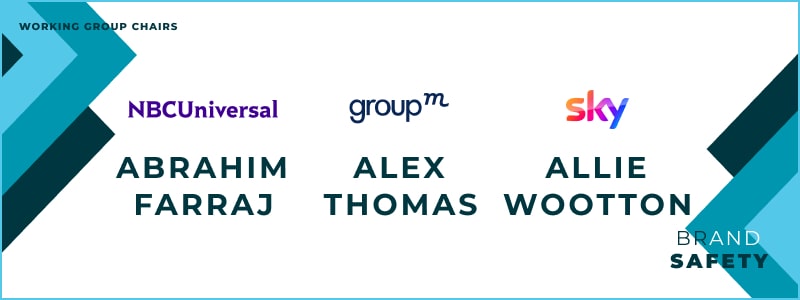TAG's brand safety programs bring the industry together to significantly reduce the risk of ad misplacement across the digital trading ecosystem.
#BrandSafety
Consumers associate a brand's advertising with the context in which those advertisements are displayed. Because the adjacency of an advertisement to specific types of content can cause significant damage to a brand's consumer reputation and revenue, it is imperative that advertisers have a way to ensure that their ads are not misplaced on digital media properties that contain illegal, objectionable, or even simply irrelevant content.
80 percent of consumers said they would reduce or stop buying a product they regularly purchase if it advertised in a range of hypothetical situations involving extreme or dangerous content.Consumer Perceptions Around Brand Safe Advertising

The mission of the TAG Brand Safety Certified Program is to significantly reduce the risk of the misplacement of advertising on digital media of all types, thereby upholding brand safety and protecting the integrity of digital advertising.
The TAG Brand Safety Certified Program promotes the flow of advertising budgets to participants in digital advertising upholding an industry regulated framework for brand safety. The program serves the entire digital advertising supply chain by providing transparency, choice and control for buyers – enabling them to buy advertising inventory with confidence and creating a brand safety framework for sellers that increases the value of certified sellers' inventory.
Find Certified Partners Get Certified!
Summary Brand Safety Certified Video

To enable companies to promote a brand-safe environment, the TAG Brand Safety Working Group maintains the Brand Safety Certified Guidelines, which promote the flow of advertising budgets to participants in digital advertising upholding an industry-regulated framework for brand safety and anti-piracy.

Keyword exclusion lists are a core component of most brand safety strategies, but they are also one of the most problematic for publishers. Too often, such exclusion lists encompass not only effective and targeted terms, but also keywords that are overly broad, irrelevant, or outdated. In addition, once added to a list, keywords are rarely removed, even if the term is no longer effective or related to the advertiser’s brand safety strategy.
Keywords are only as effective as the process by which they are selected, reviewed, and updated, yet the digital advertising industry has lacked a standard playbook of best practices for the use of keyword exclusion lists or a practical toolset to manage those efforts.
As part of the Be Bold for Publishers initiative, TAG is introducing the new Keyword Exclusion List Toolset. The industry-collaborated toolset comprises 3 elements:
1. Always Block Keyword List.



Advances in AI can have incredible benefits to Publishers. But, confronted with the nearly unlimited ability to generate synthetic content via AI, Publishers investing in human created content require help to maintain assurance in the responsibility of their processes, and accountability for their content.
TAG’s Human-Created Content Tool helps Publishers and Advertisers distinguish between human-made and AI-generated content.
The tool will be launching soon!
Mobile piracy – or the placement of legitimate ads on mobile sites and apps with infringing content – is an endemic problem needs to be addressed in order to minimize ad-supported piracy revenue flowing to criminals. While app stores are often successful at removing intellectual property-infringing apps, those apps may be downloaded thousands – or even millions – of times before they are removed. Those apps may continue to operate at scale and generate revenue through advertisements, thereby exacerbating the piracy problem.
The Pirate Mobile App List (PMAL) provides brands with a list of mobile apps that were removed from App Stores for infringing on protected intellectual property rights, but may still be active on user's devices and seeking ad spend to monetize pirated content. Through PMAL, TAG empowers brands and their partners to stem the flow of ad revenue to mobile apps with pirated content.
PMAL is part of the Brand Safety Certified program, or TAG members may purchase it separately.
Learn More About TAG Membership

In 2024, TAG expanded its proven anti-piracy initiative to protect advertisers from having their ads inadvertently appearing on websites with pirated content. A key feature of this evolution is the Pirate Domain Exclusion List (PDEL).
PDEL provides ad tech companies with an AdSec Threat Exchange-contributed list of domains that have been identified to include pirated content. PDEL aggregates member-contributed data to assist companies in identifying potential domains with pirated content.
TAG does not select, curate or modify submissions. Companies are responsible for conducting their own due diligence of domains included in PDEL.
For more information about PDEL or to join this important initiative, please contact us at antipiracy@tagtoday.net.
Together, we can make a significant impact in safeguarding digital advertising.

Having brand safety parameters and following the industry guidelines to uphold brand safety continually helps advertisers maintain consumer trust and brand integrity in the digital landscape. TAG's brand safety research and whitepapers arms brands, marketers and the adtech community:
1. key trend on brand safety factors that affect consumer purchases.